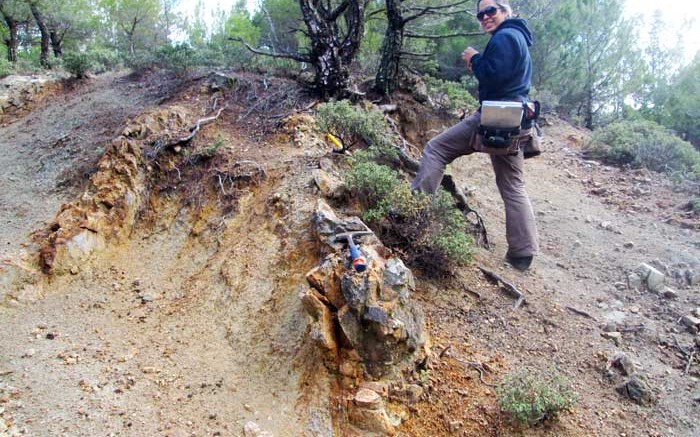VANCOUVER — With its first hole into a new target, Pilot Gold (TSX: PLG; US-OTC: PLGTF) has found a copper–gold porphyry at its TV Tower project in Turkey, reinforcing the district-scale potential of the large land package.
The first drill test of the Valley porphyry target returned 0.99 gram gold per tonne and 0.39% copper over 153 metres, starting from surface and including 66.2 metres carrying 1.57 grams gold and 0.56% copper.
Pilot homed in on the Valley target after sampling soil on the land it acquired south of its original TV Tower property. The sampling outlined a large copper- and gold-in-soil anomaly, running 1.4 km along a northwest strike and stretching 400 metres wide.
“What really led us to make this a priority was the elevated copper-in-soil,” Pilot Gold president and CEO Matt Lennox-King says in an interview. “Then coming in closer — mapping and prospecting and working up the target — we started to see porphyry outcrops with stockworking and really nice alteration, and ultimately really nice grades in grab samples as well.”
This persisted at depth: the core shows what Pilot describes as moderate to strong pervasive potassium feldspar and sericite alteration, with dense stockworking.
Most of the core is sulphidic (not oxidized), which suggests an original oxide blanket has eroded away. But this is not the case at the K2 trend 1 km north, Pilot’s last porphyry discovery. There, an oxide blanket covers a supergene enrichment layer, under which lies primary copper–gold porphyry mineralization.
Pilot has only finished one drill program at K2, which began at an oxide gold trend between the Kayali and Karaayi targets. In that 4,900-metre program the 4 km long trend returned a best oxide intercept of 119.8 metres grading 0.8 gram gold, a best supergene intercept of 1.29% copper over 34.1 metres and a best porphyry result of 224.8 metres grading 0.3% copper and 0.13 gram gold.
The Valley target is smaller than K2, at least in terms of surface expression, but its soils and initial drill hole have carried better copper grades.
Lennox-King says Pilot has already drilled four holes at Valley, with the results pending. The company will punch another five into the target before moving the drill back to the K2 trend, which has seen only limited exploration.
Pilot is mobilizing a second drill to TV Tower, but instead of moving south the rig will stay north in the property to test the Columbaz target.
“Part of our goal this year is to really reinforce the district-scale potential here at TV Tower,” Lennox-King says. “There is a wealth of attractive targets at the property, but Columbaz has some of the highest grades at surface that we’ve seen. It’s a vein target, it’s over a kilometre long, it shows all the right textures — but the really exciting thing is that we have a number of ounces and multi-ounce samples in gold and tens of ounces of silver at surface. And it has not been drilled.”
TV Tower is in northwest Turkey’s Biga district. Pilot’s first focus at the project was Kucukdag, an area in the north that hosts a gold zone with 11.6 million indicated tonnes grading 1.22 grams gold and 1.7 million inferred tonnes averaging 0.85 gram gold. A contiguous silver zone hosts 11.4 million indicated tonnes grading 46.7 grams silver per tonne and 9.1 million inferred tonnes grading 52.7 grams silver.
The project is a joint venture between Pilot Gold and Teck Resources (TSX: TCK.B; NYSE: TCK). Teck holds a 60% stake and Pilot owns 40%, but by funding $21-million worth of exploration over three years, Pilot can boost its stake to 60%.
Lennox-King says that goal is in the company’s sights. At the start of 2014 Pilot had budgeted $4.5 million of work for this year to complete its 60% earn-in.
On news of the Valley porphyry drill results, Pilot’s share price gained 7¢ to close at $1.50.
The firm has a 52-week share price range of 71¢ to $1.75, and 103 million shares outstanding.


Be the first to comment on "Another Turkish porphyry for Pilot and Teck"